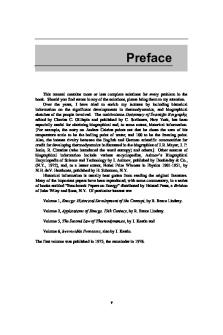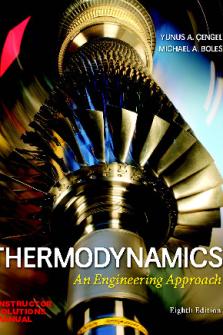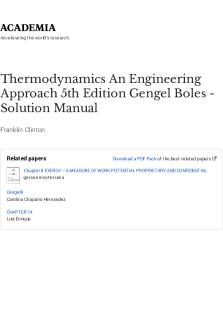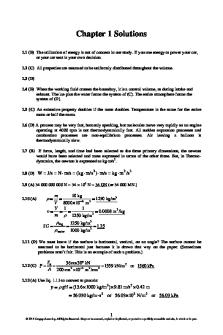Thermodynamics 8th Edition Cengel Solution Manual PDF

| Title | Thermodynamics 8th Edition Cengel Solution Manual |
|---|---|
| Author | Raw Chicken |
| Course | Thermodynamics A |
| Institution | Universiteit Stellenbosch |
| Pages | 66 |
| File Size | 2.2 MB |
| File Type | |
| Total Downloads | 215 |
| Total Views | 1,269 |
Summary
Solutions to Chapter 2...
Description
2-1
Solutions Manual for
Thermodynamics: An Engineering Approach 8th Edition Yunus A. Cengel, Michael A. Boles McGraw-Hill, 2015
Chapter 2 ENERGY, ENERGY TRANSFER, AND GENERAL ENERGY ANALYSIS
PROPRIETARY AND CONFIDENTIAL This Manual is the proprietary property of McGraw-Hill Education and protected by copyright and other state and federal laws. By opening and using this Manual the user agrees to the following restrictions, and if the recipient does not agree to these restrictions, the Manual should be promptly returned unopened to McGraw-Hill Education: This Manual is being provided only to authorized professors and instructors for use in preparing for the classes using the affiliated textbook. No other use or distribution of this Manual is permitted. This Manual may not be sold and may not be distributed to or used by any student or other third party. No part of this Manual may be reproduced, displayed or distributed in any form or by any means, electronic or otherwise, without the prior written permission of McGraw-Hill Education.
PROPRIETARY MATERIAL. © 2015 McGraw-Hill Education. Limited distribution permitted only to teachers and educators for course preparation. If you are a student using this Manual, you are using it without permission.
2-2 Forms of Energy
2-1C The sum of all forms of the energy a system possesses is called total energy . In the absence of magnetic, electrical and surface tension effects, the total energy of a system consists of the kinetic, potential, and internal energies.
2-2C The internal energy of a system is made up of sensible, latent, chemical and nuclear energies. The sensible internal energy is due to translational, rotational, and vibrational effects.
2-3C Thermal energy is the sensible and latent forms of internal energy, and it is referred to as heat in daily life.
2-4C The mechanical energy is the form of energy that can be converted to mechanical work completely and directly by a mechanical device such as a propeller. It differs from thermal energy in that thermal energy cannot be converted to work directly and completely. The forms of mechanical energy of a fluid stream are kinetic, potential, and flow energies.
2-5C Hydrogen is also a fuel, since it can be burned, but it is not an energy source since there are no hydrogen reserves in the world. Hydrogen can be obtained from water by using another energy source, such as solar or nuclear energy, and then the hydrogen obtained can be used as a fuel to power cars or generators. Therefore, it is more proper to view hydrogen is an energy carrier than an energy source.
2-6C In electric heaters, electrical energy is converted to sensible internal energy.
2-7C The forms of energy involved are electrical energy and sensible internal energy. Electrical energy is converted to sensible internal energy, which is transferred to the water as heat.
2-8E The total kinetic energy of an object is given is to be determined. Analysis The total kinetic energy of the object is given by
KE m
(50 ft/s ) 2 V2 (10 lbm) 2 2
1 Btu/lbm 25,037 ft 2 /s 2 0.499 Btu 0.50 Btu
PROPRIETARY MATERIAL. © 2015 McGraw-Hill Education. Limited distribution permitted only to teachers and educators for course preparation. If you are a student using this Manual, you are using it without permission.
2-3 2-9E The total potential energy of an object is to be determined. Analysis Substituting the given data into the potential energy expression gives
1 Btu/lbm PE mgz (200 lbm)(32.2 ft/s 2 )(10 ft) 25,037 ft 2 /s 2
2.57 Btu
2-10 A person with his suitcase goes up to the 10 th floor in an elevator. The part of the energy of the elevator stored in the suitcase is to be determined. Assumptions 1 The vibrational effects in the elevator are negligible. Analysis The energy stored in the suitcase is stored in the form of potential energy, which is mgz. Therefore,
1 kJ/kg Esuitcase PE mg z (30 kg)(9.81m/s 2 )(35 m) 10.3 kJ 1000 m2 /s2 Therefore, the suitcase on 10 th floor has 10.3 kJ more energy compared to an identical suitcase on the lobby level. Discussion Noting that 1 kWh = 3600 kJ, the energy transferred to the suitcase is 10.3/3600 = 0.0029 kWh, which is very small.
2-11 A hydraulic turbine-generator is to generate electricity from the water of a large reservoir. The power generation potential is to be determined. Assumptions 1 The elevation of the reservoir remains constant. 2 The mechanical energy of water at the turbine exit is negligible. Analysis The total mechanical energy water in a reservoir possesses is equivalent to the potential energy of water at the free surface, and it can be converted to work entirely. Therefore, the power potential of water is its potential energy, gz for a given mass flow rate. which is gz per unit mass, and m
120 m
1 kJ/kg 1.177 kJ/kg emech pe gz (9.81 m/s2 )(120 m) 1000 m 2 /s 2
Turbine
Generator
Then the power generation potential becomes
1 kW emech (2400 kg/s)(1.177 kJ/kg) 2825 kW W max E mech m 1 kJ/s Therefore, the reservoir has the potential to generate 2825 kW of power. Discussion This problem can also be solved by considering a point at the turbine inlet, and using flow energy instead of potential energy. It would give the same result since the flow energy at the turbine inlet is equal to the potential energy at the free surface of the reservoir.
PROPRIETARY MATERIAL. © 2015 McGraw-Hill Education. Limited distribution permitted only to teachers and educators for course preparation. If you are a student using this Manual, you are using it without permission.
2-4 2-12 Wind is blowing steadily at a certain velocity. The mechanical energy of air per unit mass and the power generation potential are to be determined. Assumptions The wind is blowing steadily at a constant uniform velocity. Properties The density of air is given to be = 1.25 kg/m3. Analysis Kinetic energy is the only form of mechanical energy the wind possesses, and it can be converted to work entirely. Therefore, the power potential of the wind is its V 2 / 2 for kinetic energy, which is V2/2 per unit mass, and m a given mass flow rate:
emech ke
Wind turbine
Wind 10 m/s
60 m
2 V 2 (10 m/s) 1 kJ/kg 0.050 kJ/kg 2 2 1000 m 2/s 2
m VA V
D 2 4
3 (1.25 kg/m )(10 m/s)
(60 m) 2 4
35,340 kg/s
max E mech m emech (35,340 kg/s)(0.050 kJ/kg) 1770 kW W Therefore, 1770 kW of actual power can be generated by this wind turbine at the stated conditions. Discussion The power generation of a wind turbine is proportional to the cube of the wind velocity, and thus the power generation will change strongly with the wind conditions.
2-13 A water jet strikes the buckets located on the perimeter of a wheel at a specified velocity and flow rate. The power generation potential of this system is to be determined. Assumptions Water jet flows steadily at the specified speed and flow rate. Analysis Kinetic energy is the only form of harvestable mechanical energy the water jet possesses, and it can be converted to work entirely. Therefore, the power potential of the water jet is its kinetic energy, V 2 / 2 for a given mass flow rate: which is V2/2 per unit mass, and m
e mech ke
V 2 (60 m/s) 2 1 kJ/kg 1.8 kJ/kg 2 2 1000 m 2 /s2
emech W max Emech m 1 kW (120 kg/s)(1.8 kJ/kg) 216 kW 1 kJ/s
Shaft Nozzle
Vj
Therefore, 216 kW of power can be generated by this water jet at the stated conditions. Discussion An actual hydroelectric turbine (such as the Pelton wheel) can convert over 90% of this potential to actual electric power.
PROPRIETARY MATERIAL. © 2015 McGraw-Hill Education. Limited distribution permitted only to teachers and educators for course preparation. If you are a student using this Manual, you are using it without permission.
2-5 2-14 Two sites with specified wind data are being considered for wind power generation. The site better suited for wind power generation is to be determined. Assumptions 1The wind is blowing steadily at specified velocity during specified times. 2 The wind power generation is negligible during other times. Properties We take the density of air to be = 1.25 kg/m3 (it does not affect the final answer). Analysis Kinetic energy is the only form of mechanical energy the wind possesses, and it can be converted to work entirely. Therefore, the power potential of the wind is its kinetic energy, V 2 / 2 for a given mass flow which is V2/2 per unit mass, and m rate. Considering a unit flow area (A = 1 m2), the maximum wind power and power generation becomes
e mech, 1 ke 1
Wind
Wind turbine
V, m/s
V 12 (7 m/s) 2 1 kJ/kg 0.0245 kJ/kg 2 2 2 2 1000 m /s
emech, 2 ke 2
V22 (10 m/s) 2 1 kJ/kg 0.050 kJ/kg 2 2 2 2 1000 m /s
W 1 emech, 1 V1 Ake1 (1.25 kg/m3 )(7 m/s)(1 m 2 )(0.0245 kJ/kg) 0.2144 kW max, 1 Emech, 1 m W 2 emech, 2 V2 Ake2 (1.25 kg/m 3 )(10 m/s)(1 m 2 )(0.050 kJ/kg) 0.625 kW max, 2 Emech, 2 m since 1 kW = 1 kJ/s. Then the maximum electric power generations per year become
Emax, 1 Wmax, 1 t1 (0.2144 kW)(3000 h/yr) 643 kWh/yr (per m 2 flow area) E max, 2 Wmax, 2 t2 (0.625 kW)(1500 h/yr) 938 kWh/yr (per m 2 flow area) Therefore, second site is a better one for wind generation. Discussion Note the power generation of a wind turbine is proportional to the cube of the wind velocity, and thus the average wind velocity is the primary consideration in wind power generation decisions.
PROPRIETARY MATERIAL. © 2015 McGraw-Hill Education. Limited distribution permitted only to teachers and educators for course preparation. If you are a student using this Manual, you are using it without permission.
2-6 2-15 A river flowing steadily at a specified flow rate is considered for hydroelectric power generation by collecting the water in a dam. For a specified water height, the power generation potential is to be determined. Assumptions 1 The elevation given is the elevation of the free surface of the river. 2 The mechanical energy of water at the turbine exit is negligible. Properties We take the density of water to be = 1000 kg/m3.
River
Analysis The total mechanical energy the water in a dam possesses is equivalent to the potential energy of water at the free surface of the dam (relative to free surface of discharge water), and it can be converted to work entirely. Therefore, the power potential of water is gz for a given its potential energy, which is gz per unit mass, and m mass flow rate.
80 m
1 kJ/kg 2 0.7848 kJ/kg emech pe gz (9.81 m/s )(80 m) 1000 m2 /s2 The mass flow rate is
V (1000 kg/m 3 )(175 m 3/s) 175,000 kg/s m Then the power generation potential becomes
max E mech m emech (175,000 kg/s)(0.7848 kJ/kg) 1 MW 137 MW W 1000 kJ/s Therefore, 1 37 MW of power can be generated from this river if its power potential can be recovered completely. Discussion Note that the power output of an actual turbine will be less than 137 MW because of losses and inefficiencies.
2-16 A river is flowing at a specified velocity, flow rate, and elevation. The total mechanical energy of the river water per unit mass, and the power generation potential of the entire river are to be determined. Assumptions 1 The elevation given is the elevation of the free surface of the river. 2 The velocity given is the average velocity. 3 The mechanical energy of water at the turbine exit is negligible. Properties We take the density of water to be = 1000 kg/m3.
River
3 m/s
Analysis Noting that the sum of the flow energy and the potential energy is constant for a given fluid body, we can take the elevation of the entire river water to be the elevation of the free surface, and ignore the flow energy. Then the total mechanical energy of the river water per unit mass becomes
emech pe ke gh
90 m
(3 m/s)2 1 kJ/kg V 2 (9.81 m/s2 )(90 m) 1000 m 2/s 2 0.887 kJ/kg 2 2
The power generation potential of the river water is obtained by multiplying the total mechanical energy by the mass flow rate,
V (1000 kg/m 3 )(500 m 3/s) 500,000 kg/s m emech (500,000 kg/s)(0.887 kJ/kg) 444,000 kW 444 MW W max E mech m Therefore, 444 MW of power can be generated from this river as it discharges into the lake if its power potential can be recovered completely. Discussion Note that the kinetic energy of water is negligible compared to the potential energy, and it can be ignored in the analysis. Also, the power output of an actual turbine will be less than 444 MW because of losses and inefficiencies. PROPRIETARY MATERIAL. © 2015 McGraw-Hill Education. Limited distribution permitted only to teachers and educators for course preparation. If you are a student using this Manual, you are using it without permission.
2-7 Energy Transfer by Heat and Work
2-17C The form of energy that crosses the boundary of a closed system because of a temperature difference is heat; all other forms are work.
2-18C (a) The car's radiator transfers heat from the hot engine cooling fluid to the cooler air. No work interaction occurs in the radiator. (b) The hot engine transfers heat to cooling fluid and ambient air while delivering work to the transmission. (c) The warm tires transfer heat to the cooler air and to some degree to the cooler road while no work is produced. No work is produced since there is no motion of the forces acting at the interface between the tire and road. (d) There is minor amount of heat transfer between the tires and road. Presuming that the tires are hotter than the road, the heat transfer is from the tires to the road. There is no work exchange associated with the road since it cannot move. (e) Heat is being added to the atmospheric air by the hotter components of the car. Work is being done on the air as it passes over and through the car.
2-19C (a) From the perspective of the contents, heat must be removed in order to reduce and maintain the content's temperature. Heat is also being added to the contents from the room air since the room air is hotter than the contents. (b) Considering the system formed by the refrigerator box when the doors are closed, there are three interactions, electrical work and two heat transfers. There is a transfer of heat from the room air to the refrigerator through its walls. There is also a transfer of heat from the hot portions of the refrigerator (i.e., back of the compressor where condenser is placed) system to the room air. Finally, electrical work is being added to the refrigerator through the refrigeration system. (c) Heat is transferred through the walls of the room from the warm room air to the cold winter air. Electrical work is being done on the room through the electrical wiring leading into the room.
2-20C It is a work interaction.
2-21C It is a work interaction since the electrons are crossing the system boundary, thus doing electrical work.
2-22C It is a heat interaction since it is due to the temperature difference between the sun and the room.
2-23C This is neither a heat nor a work interaction since no energy is crossing the system boundary. This is simply the conversion of one form of internal energy (chemical energy) to another form (sensible energy).
PROPRIETARY MATERIAL. © 2015 McGraw-Hill Education. Limited distribution permitted only to teachers and educators for course preparation. If you are a student using this Manual, you are using it without permission.
2-8 2-24 The power produced by an electrical motor is to be expressed in different units. Analysis Using appropriate conversion factors, we obtain (a)
1 J/s 1 N m W (5 W) 1 W 1 J
5 N m/s
(b)
1 J/s 1 N m W (5 W) 1 W 1 J
2 1 kg m/s 1N
5 kg m2 /s 3
2-25E The power produced by a model aircraft engine is to be expressed in different units. Analysis Using appropriate conversion factors, we obtain (a)
1 Btu/s 778.169 lbf ft/s W (10 W) 7.38 lbf ft/s 1 Btu/s 1055.056 W
(b)
1 hp W (10 W) 0.0134 hp 745.7 W
Mechanical Forms of Work 2-26C The work done is the same, but the power is different.
2-27E A construction crane lifting a concrete beam is considered. The amount of work is to be determined considering (a) the beam and (b) the crane as the system. Analysis (a ) The work is done on the beam and it is determined from
1 lbf ( 24 ft ) W mgz (3 2000 lbm)( 32.174 ft/s 2 ) 2 32.174 lbm ft/s 144,000 lbf ft
24 ft
1 Btu 185 Btu (144,000 lbf ft) 778.169 lbf ft (b) Since the crane must produce the same amount of work as is required to lift the beam, the work done by the crane is
W 144,000lbf ft 185 Btu
PROPRIETARY MATERIAL. © 2015 McGraw-Hill Education. Limited distribution permitted only to teachers and educators for course preparation. If you are a student using this Manual, you are using it without permission.
2-9 2-28E A man is pushing a cart with its contents up a ramp that is inclined at an angle of 10° from the horizontal. The work needed to move along this ramp is to be determined considering (a) the man and (b) the cart and its contents as the system. Analysis (a ) Considering the man as the system, letting l be the displacement along the ramp, and letting be the inclination angle of the ramp,
W Fl sin (100 180 lbf )(100 ft)sin(10) 4862 lbf ft 1 Btu 6.248 Btu (4862 lbf ft) 778.169 lbf ft This is work that the man must do to raise the weight of the cart and contents, plus his own weight, a distance of lsin. (b) Applying the same logic to the cart and its contents gives
W Fl sin (100 lbf )(100 ft)sin(10) 1736 lbf ft 1 Btu 2.231Btu (1736 lbf ft) 778.169 lbf ft
2-29E The work required to compress a spring is to be determined. Analysis Since there is no preload, F = kx. Substituting this into the work expression gives 2
2
2
W Fds kxdx k xdx 1
1
1
200 lbf/in (1 in)2 02 2
k 2 (x x12 ) 2 2
F
121ftin 8.33 lbf ft
x
1 Btu (8.33 lbf ft) 0.0107 Btu 778 . 169 lbf ft
2-30 A car is accelerated from 10 to 60 km/h on an uphill road. The work needed to achieve this is to be determined. Analysis The total work required is the sum of the changes in potential and kinetic energies,
Wa
and
60,000 m 2 10,000 m 2 1 1 1 kJ 175.5 kJ m V22 V12 (1300 kg) 3600 s 3600 s 1000 kg m 2/s 2 2 2
1 kJ 510.0 kJ Wg mg z2 z1 (1300 kg)(9.81 m/s2 )(40 m) 2 2 1000 kg m /s
Thus,
Wtotal Wa Wg ...
Similar Free PDFs
Popular Institutions
- Tinajero National High School - Annex
- Politeknik Caltex Riau
- Yokohama City University
- SGT University
- University of Al-Qadisiyah
- Divine Word College of Vigan
- Techniek College Rotterdam
- Universidade de Santiago
- Universiti Teknologi MARA Cawangan Johor Kampus Pasir Gudang
- Poltekkes Kemenkes Yogyakarta
- Baguio City National High School
- Colegio san marcos
- preparatoria uno
- Centro de Bachillerato Tecnológico Industrial y de Servicios No. 107
- Dalian Maritime University
- Quang Trung Secondary School
- Colegio Tecnológico en Informática
- Corporación Regional de Educación Superior
- Grupo CEDVA
- Dar Al Uloom University
- Centro de Estudios Preuniversitarios de la Universidad Nacional de Ingeniería
- 上智大学
- Aakash International School, Nuna Majara
- San Felipe Neri Catholic School
- Kang Chiao International School - New Taipei City
- Misamis Occidental National High School
- Institución Educativa Escuela Normal Juan Ladrilleros
- Kolehiyo ng Pantukan
- Batanes State College
- Instituto Continental
- Sekolah Menengah Kejuruan Kesehatan Kaltara (Tarakan)
- Colegio de La Inmaculada Concepcion - Cebu















